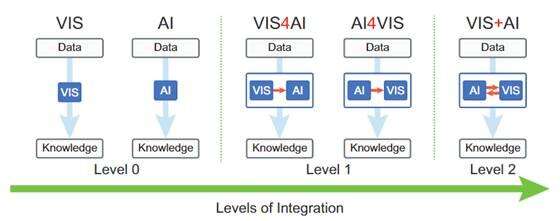This article has been reviewed according to Science X's editorial process and policies. Editors have highlighted the following attributes while ensuring the content's credibility:
fact-checked
proofread
Integrating visualization with artificial intelligence for efficient data analysis

Visualization and artificial intelligence (AI) are well-applied approaches to data analysis. In complex data analysis scenarios, like epidemic traceability and city planning, humans need to understand large-scale data and make decisions, which requires complementing the strengths of both visualization and AI. However, integrating these into data analysis processes has yet to be accomplished.
A research team led by Prof. Wei Chen has published new research on this topic in Frontiers of Computer Science.
The team define three integration levels of visualization and AI. Visualization and AI are first used separately, which are data analysis approaches at level 0: independent process. As the technology matures, visualization and AI have been applied to assist each other. Related approaches are known as VIS4AI and AI4VIS, which correspond to level 1: one-way assistance. One-way assistance cannot support feedback. Approaches at level 1 have no chance to assess or optimize the effect of the provided assistance. To further improve data analysis approaches, the next level requires dual-way assistance, which is level 2: deep integration.
VIS+AI aims at barrier-free communication between human intelligence and artificial intelligence in the scenario of visual analysis. The framework of VIS+AI can completely open up the channel between AI and visualization, which further links human intelligence. As shown on the left of the framework in the image above, the knowledge generation model is inherited from the previous level to inject human intelligence.

As shown on the right of the framework, the channel between AI and visualization consists of three iterative loops: an interaction loop, an execution loop, and an intelligence optimization loop. Through the three loops, AI can adapt to dynamic data analysis processes, and therefore be deeply involved into the data analysis processes guided by humans.
More information: Xumeng Wang et al, VIS+AI: integrating visualization with artificial intelligence for efficient data analysis, Frontiers of Computer Science (2023). DOI: 10.1007/s11704-023-2691-y
















